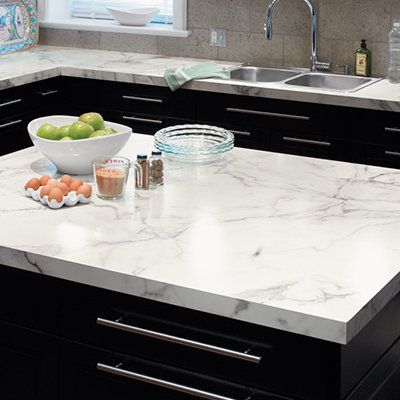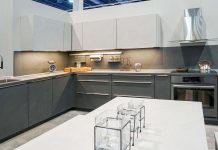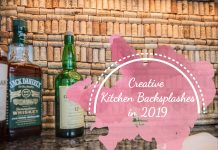Many people would say that your kitchen countertop is THE most important part of your kitchen. For all intents and purpose, your countertops will be designed the same and provide the same basic function regardless of what countertop material is used. And yet, the material that you choose for your kitchen counter will make all the difference in the world. When most people talk about countertops, they discuss the big three: Stone, Hard Surface, and Tile.
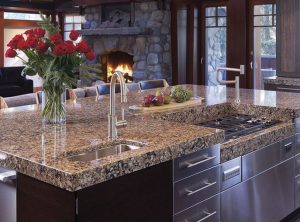
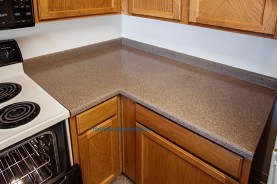
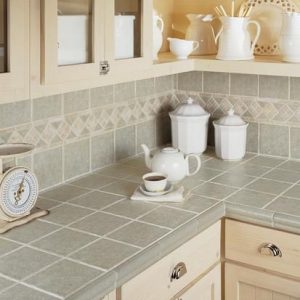
But this time we’re not going to be lazy like most. We are going over the big three and all the little obscure countertop materials that you’ve heard of, and probably some you haven’t.
There is NO perfect countertop material. Different people can often have wildly different priorities when it comes to kitchen countertop materials. For many people it is the appearance of the countertop. For others it is mostly about how easy or difficult it is to keep the countertop clean. Some people appreciate the look but also place a priority on the tactile feel of the material. The lasting longevity or lifetime of the material is a big priority for most, particularly when making investments as costly as new countertops. Functionality can be the biggest priority, especially for those that do a lot of cooking in their kitchen. And yet there is no denying that for so many people cost is the true priority. Some countertops are more or less susceptible to damage from cutting, chipping, heat, or some form of discoloration. The countertop material that is chosen all depends on the person and their personal priorities.
For a quick example: Many people who know me would think that the highest priority for my kitchen countertops would be cost, because I am so poor. What many people do not know is that when I lived in my first apartment I had cheap Formica countertops and during a small grease fire that I quickly put out, a pot lid was placed on the counter and burned a black ring into the countertop. I found this unacceptable.

While cost and durability are high priorities for me, in the back of my mind I am always looking for a countertop with excellent heat resistance so that I would not need trivets or spoon holders to protect it from hot objects.
Table of Contents
Stone
I feel that it is important to start with stone countertops because they are the most popular. For many years now the kitchen status symbol was the granite countertop. However in recent years there has been a steady increase in the desire for other less common stones as well as a sharp increase in the desire for Quartz. Most of these stones all share some basic features. They all provide you with a very hard and very smooth surface for you kitchen countertop.
Granite
As I stated before, granite has long be thought of as THE stone countertop to complete a high-end kitchen. Granite is a natural stone so the counter slab is cut right from rock found in nature. This means that you will never have two granite countertops that are exactly the same.

It is not hard to see the appeal for any stone countertop but the patterns and colors found in granite are particularly beautiful.
Out of laziness, I have often forgone the task of fetching a proper cutting board and ended up slicing bread, butter, cake, muffins, etc. directly on a granite countertop and to this day I have never had any problems scratching, or chipping granite. But don’t think that this is some indestructible surface. My brother once had a boss that gave him instructions to cut some cardboard on a granite countertop using a box cutter; my brother followed these instructions literally and ended up cutting some deep scratches into the expensive kitchen island. With enough force these counters can crack. I would not recommend standing on your granite countertops. Once a crack has occurred you will have to live with it, or replace the whole slab. Despite how smooth and flawless the stone feels to your fingertips, granite and most other stones are actually a little porous so if you were to spill coffee on the countertop and leave it overnight, you might end up with a stain in the counter.
Granite is truly beautiful. When paired well with the right cabinets, granite and other natural stones can achieve a subtle feat by being very modern as well as very natural at the same time.
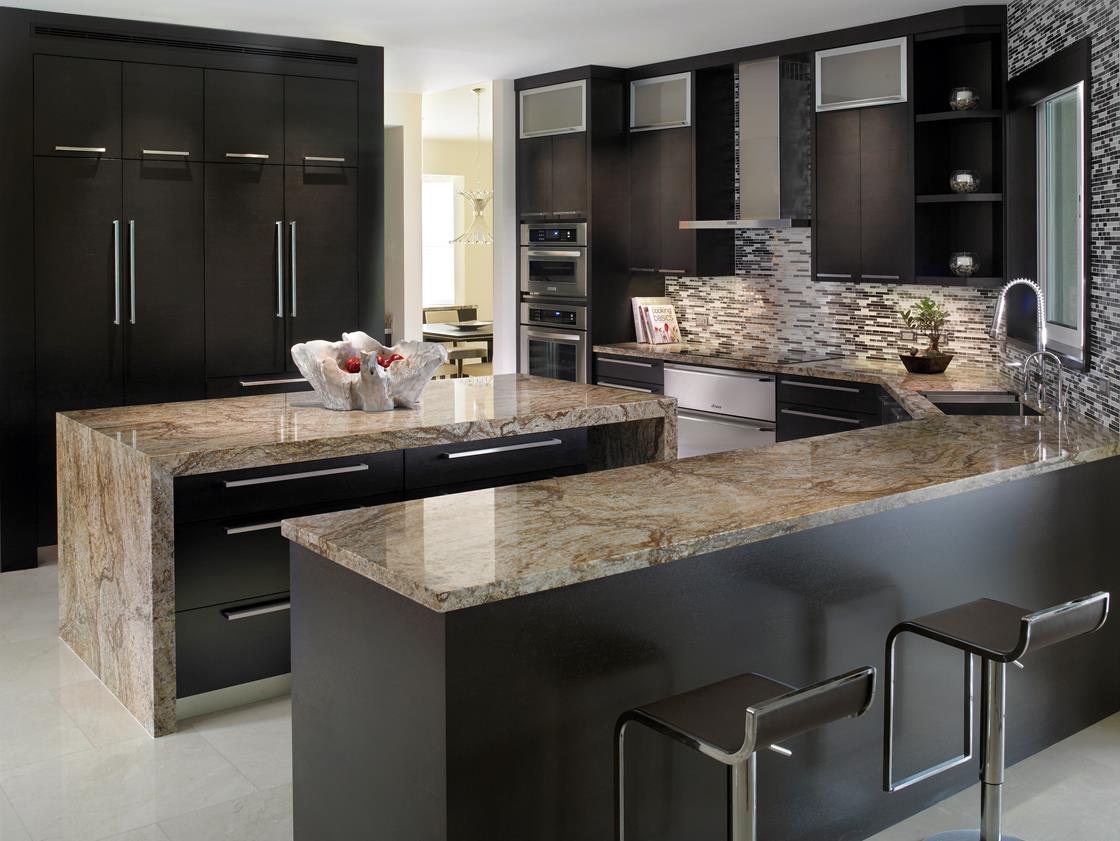
Granite is smooth, cool, hard, shiny, striking, and many other things that are sought after for an ultra-modern kitchen. But granite is unmistakably natural so it also matches and pairs well with warm wood grain cabinets that give off a comforting natural vibe for a more traditional kitchen. If you want to go with the granite “road-less-traveled” there is a rare form of cobalt blue granite called Sodalite that is used to make stunning countertops.(in blue)
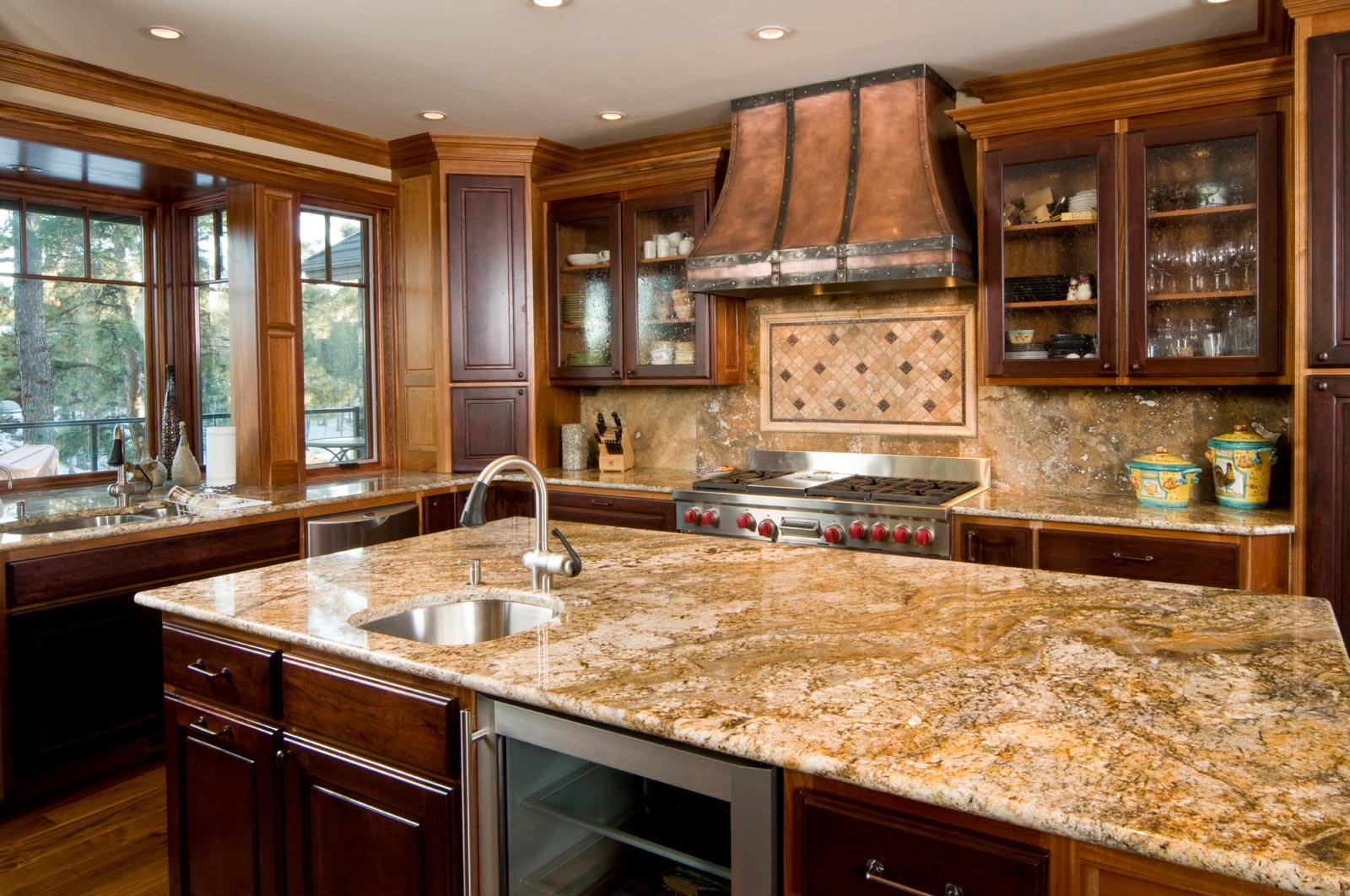
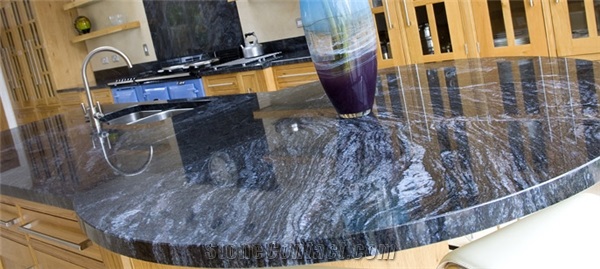
Regardless of your feelings about granite, it is a very good stone to use as a basis to compare all the other stones.
Marble
Marble is also popular, especially in bathroom vanities. When most people think of marble it is usually in the context of countertops or ancient Greek and Roman

architecture. I believe that this mental link to ancient wealth still plays a small part in our subconscious minds when choosing countertops. Also, most marble countertops are very white in color and that always gives off a very clean sensation. Like granite, marble is a natural stone so your countertop will be unique. Marble countertops are similar to granite but still a little weaker in terms of strength, hardness, longevity, durability, heat resistance, and most other factors. Marble is notably more porous than granite so be extra careful. In fact many bathroom vanities develop stains from water. It looks great but you will have to be extra careful with marble countertops if you want to use them in the kitchen.
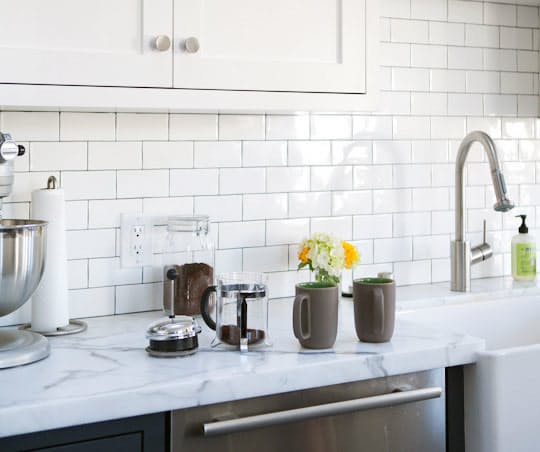
Quartz
Quartz is kind of that “new kid on the block” that is stirring things up. Quartz is a manufactured product, also referred to as an engineered stone. They take ground up chunks and bits of natural quartz (about 95%) and then add a polymer resin (about 5%) to the mix. This results in a product that looks and feels just like natural stone.
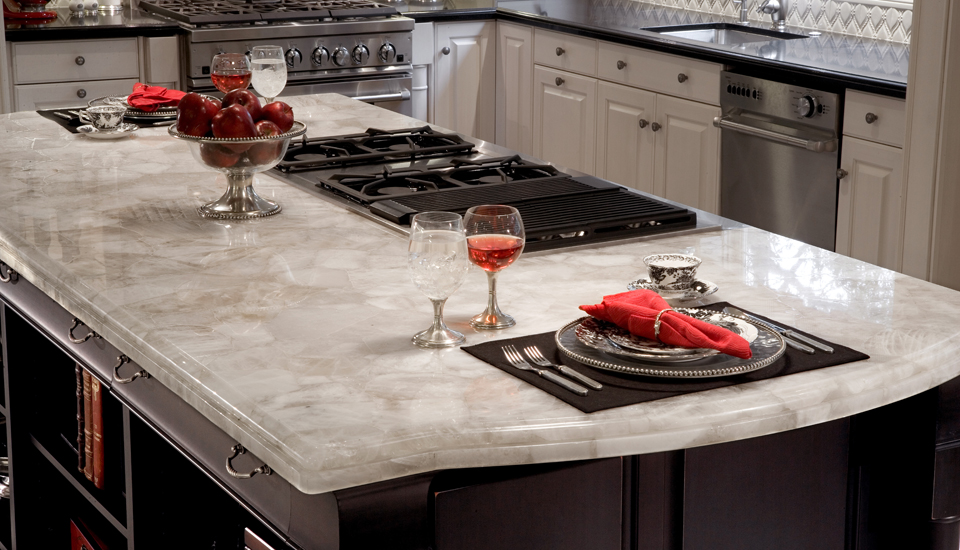
There are a lot of advantages to quartz countertops. You get all the strength and durability that you find in granite but with quartz your countertop is even less likely to chip or crack. Quartz is nonporous so it’s easy to clean and you don’t have to worry about it staining. A very cool advantage of quartz is the ability to customize the look of your countertop. There are a lot more options with quartz and if you want to pay extra
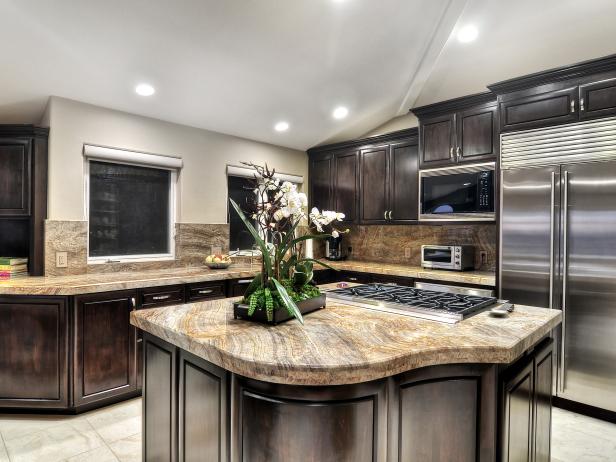
you can get custom countertops made. Many people prefer the clean man-made look of quartz over granite, especially with very modern cabinets, while others may prefer the natural subtleties of granite. Quartz tends to be considerably more expensive than granite so that is clearly a drawback for some people. Quartz countertops are the pretty good with heat but they don’t do as well as natural stone or concrete. Despite that, Quartz is a stronger and more durable stone that is nonporous so you won’t have to worry about staining. This makes Quartz a stone option that is more expensive but also less maintenance.
Slate
There is no question that quartz is a fantastic option for you kitchen countertop but there is just something about the tactile sensation you get from touching natural stone like granite, marble and slate. I remember, as a kid, crawling under our pool table and reaching up to feel the underside of the slab of slate that provides the flat uncompromising top for the billiard balls. The stone was always cool to the touch; it didn’t feel like anything else.
As countertop material, Slate is one of the best options available. If you are making a mental checklist, it is almost all pros and no cons. Slate is strong and durable. It takes a lot to scratch or crack slate, and it has a very high heat resistance.
 Best of all, slate is non-porous! You don’t have to worry about sealing it, and it won’t stain from spilled liquids. Slate is also a natural stone cut right from the earth so like granite and marble; it will be a unique countertop. This uniqueness is not as apparent as it would be with granite or marble because slate tends to have more uniformity in its color patterns. In fact this is probably the biggest drawback to slate countertops.
Best of all, slate is non-porous! You don’t have to worry about sealing it, and it won’t stain from spilled liquids. Slate is also a natural stone cut right from the earth so like granite and marble; it will be a unique countertop. This uniqueness is not as apparent as it would be with granite or marble because slate tends to have more uniformity in its color patterns. In fact this is probably the biggest drawback to slate countertops.
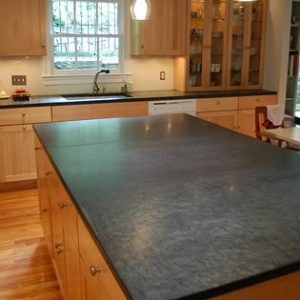
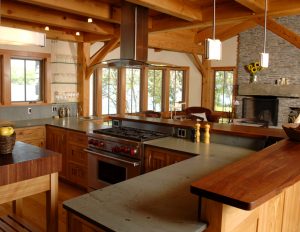
Unlike granite, slate is mostly found in shades of black, gray, charcoal, and brown. But if that does not bother you then slate can be a very appealing option. Aside from color options slate does have a tendency to chip around sharp corners so many professionals recommend that you round off the corners.
Soapstone, Limestone, and Travertine
Soapstone, Limestone, and Travertine are all used to make countertops. Many of these stones are also used to make tiles for back splashes, tile countertops, kitchen and bathroom floors, and showers. These three stones are all metamorphic rock. In fact, in a Shower Floor article that I wrote, I go into some detail about how in nature limestone eventually turns into travertine which in turn will eventually turn into marble. All of these rocks contain talc, the same mineral that is ground up to make talcum powder. Some say that this gives them a soft tactile feel but I don’t seem to notice much of a difference.
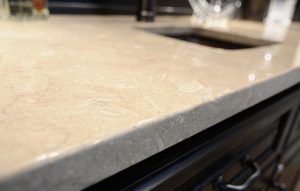
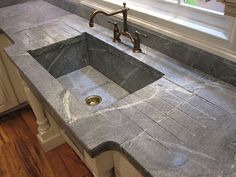
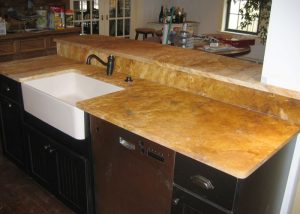
All of these stones are softer than granite or marble so they will scratch. This is the reason you see them used in kitchens far less than granite or quartz. It is best to seal the countertop to help prevent staining.
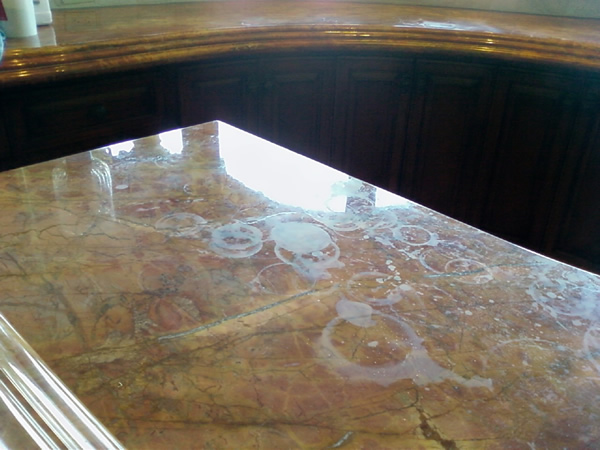
All of these stones are more porous than marble so any spills should be cleaned immediately. Their heat resistance is just as good as other natural stone countertops. It should be mentioned that these stones will give you a less common looking countertop which could be a plus for someone who is sick of granite and quartz counters. Soapstone, limestone, and travertine are good looking options for your countertop if you don’t mind a somewhat high maintenance stone.
Onyx
Onyx is the very intriguing name for a truly beautiful stone. Some refer to it as “Banded Calcite.” Onyx tends to be less opaque than other stones; because of this, some choose to light the countertops from below or install backlighting behind an onyx
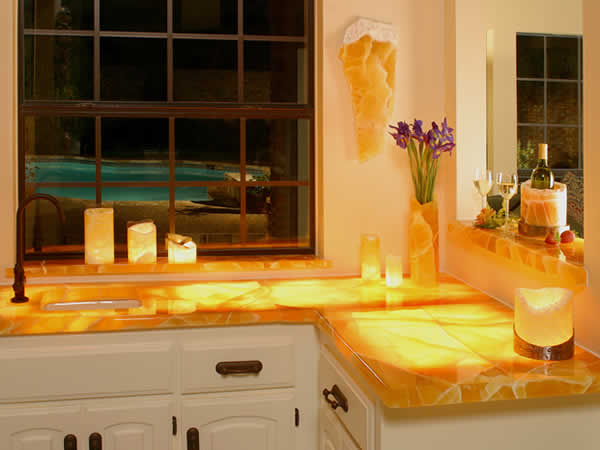
backsplash. This can result in some stunning countertops and backsplashes. Unfortunately onyx is more fragile than granite or other stones; it can stain so sealing your counters is a must. Like with limestone you should clean spills right away because onyx is naturally porous.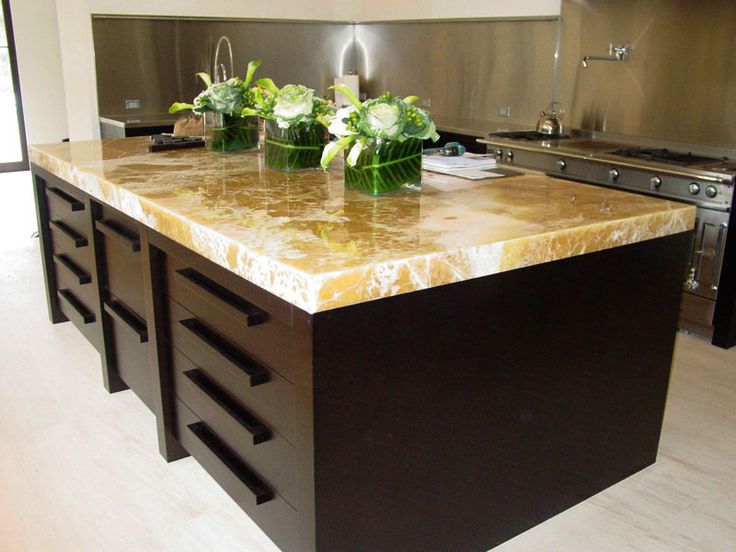
The beauty you get from Onyx is not cheap, so expect to pay a lot more.
Glazed basalt
Basalt is another name for volcanic rock. A French company is now producing a high end countertop out of glazed basalt that they are calling “Lava Stone.”
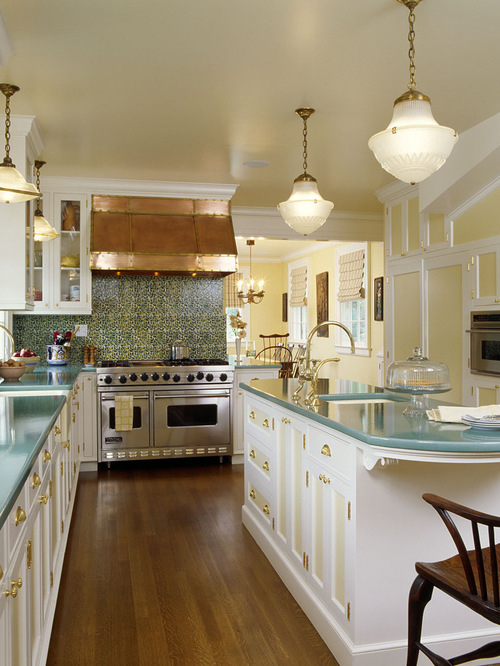
In essence, this is a slab of volcanic rock that is then glazed with some colorful enamel and fired in a giant kiln, like a piece of clay pottery or ceramic tiles. This results in a shiny smooth countertop that is very strong, very resistant to stains, scratches, extreme heat, etc. and is very durable; but also very expensive. Although this is a natural stone, the fact that they glaze the rock makes it possible for dozens and dozens of color
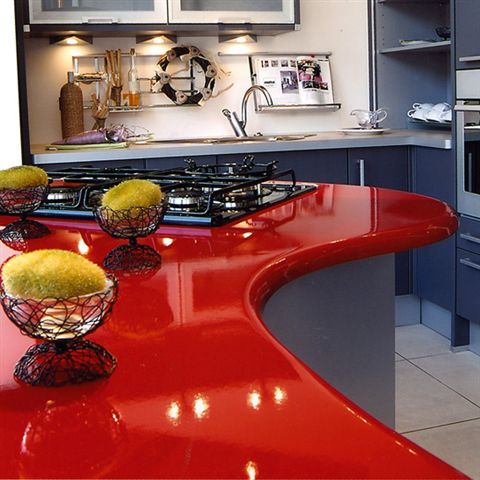
options. Aside from the cost of the product itself, another obstacle that could price these beautiful counters out of the budgets of many interested buyers is that it ONLY appears to be available in France.
Concrete
Now that more and more people are starting to use engineered stone like quartz, I am surprised that there hasn’t been a congruent increase in concrete countertops. The popularity of concrete kitchen countertops (and floors, for that matter) is on the rise, but it is still far less common than quartz or granite. There are a number of interesting options for concrete countertops.
Concrete (regular)
Since ancient Rome, mankind has shaped concrete to create incredible buildings, tools, art, etc. One of the countless ways we use it today is to form durable countertops. There are some countertops that look just like very smooth polished concrete slabs; pretty much the way you’d expect a polished sidewalk to look.
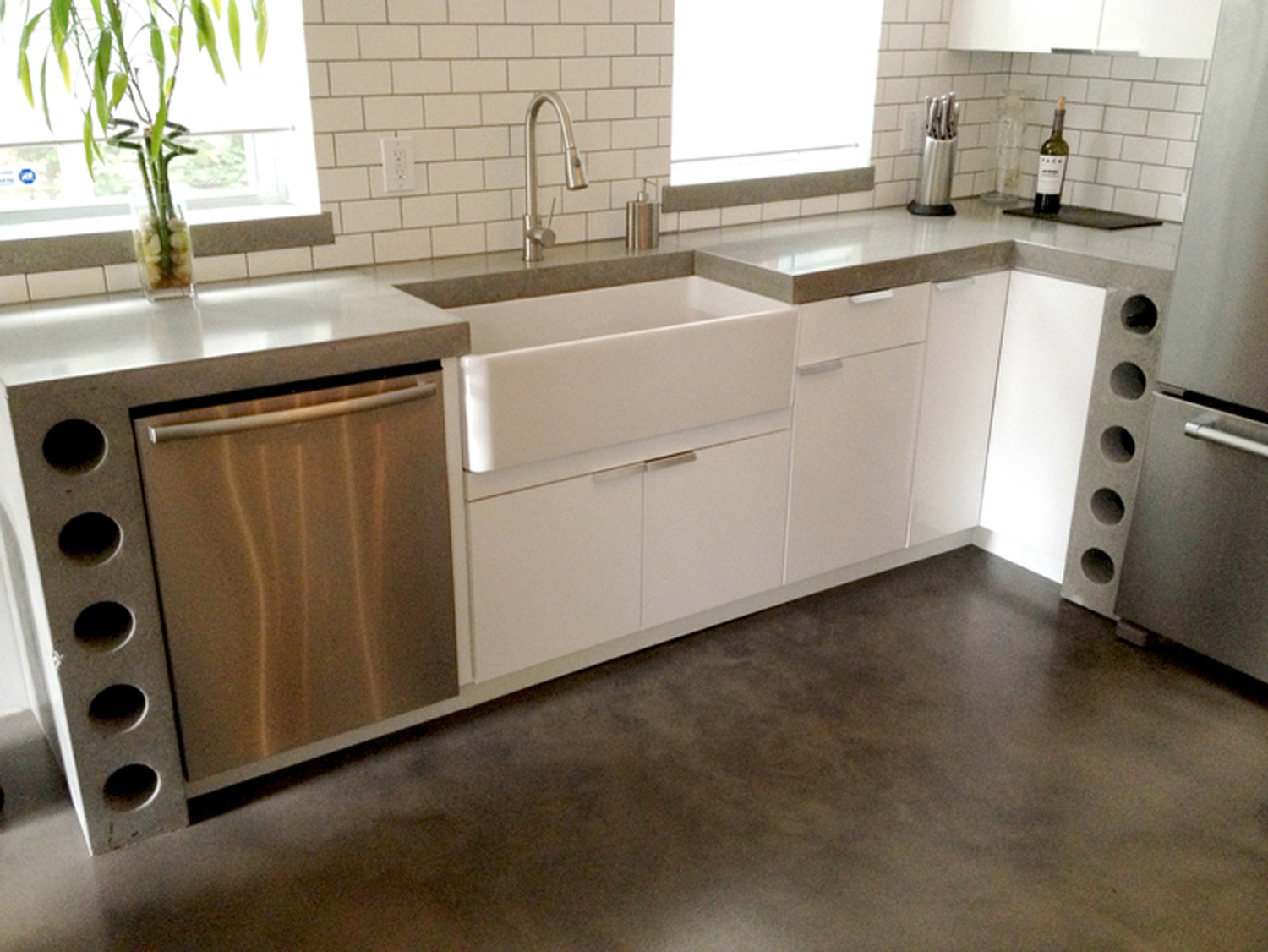
This can work very well if paired with the right cabinets. However, the majority of people who get concrete counters choose to add pigment and stain to the mix.
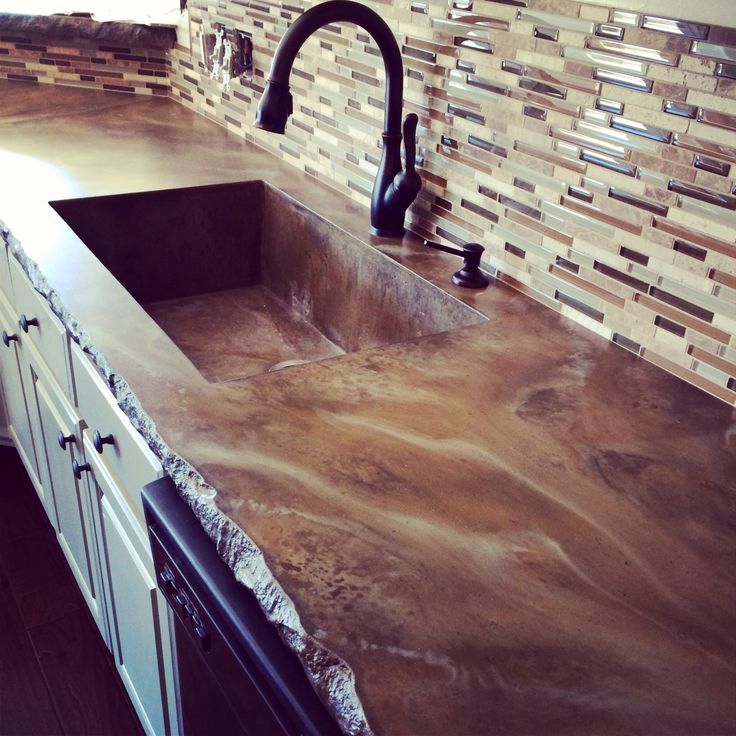
There are seemingly countless options for the ways you can change the look of your counter in terms of colors and patterns. Concrete performs very well when compared to other countertop materials. It is very hard and durable. You don’t have to worry about scratching concrete and it doesn’t matter if you place hot items right on top of it. Unfortunately, just like concrete flooring, you will have to seal your countertops every couple years. If this is not done, the porous nature of concrete will result in stains and discolorations in your countertop. While the sealing process is not prohibitively expensive, difficult, or time consuming; it is more maintenance than many people would like for their counters.
In my previous article about kitchen flooring, I mentioned that many people are putting in concrete floors or even ripping up their current floor in favor of using their concrete foundation for kitchen flooring. If one were inclined to use concrete for their floor and their countertops it might justify buying the concrete sealant in bulk.
Textured Concrete
Technically this is the same material that regular concrete would be made of but it is important to acknowledge the significant differences that the texture makes in these countertops. By texturing the concrete you are not only able to add colors and patterns but also a whole new depth to your countertops. You can mimic stone, or other surfaces.
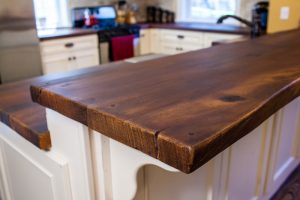 Wood form concrete countertops look and feel very similar to thick wood countertops. The effect of the texturing is fantastic. Naturally, the textured form of concrete counters share all the benefits and drawbacks of non-textured concrete.
Wood form concrete countertops look and feel very similar to thick wood countertops. The effect of the texturing is fantastic. Naturally, the textured form of concrete counters share all the benefits and drawbacks of non-textured concrete.
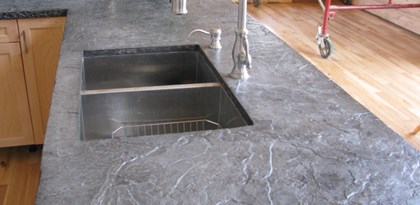
The added tactile benefit of textured concrete could make it slightly harder to clean but the difference is probably barely noticeable.
Terrazzo (aggregate)
Another option for concrete countertops is Terrazzo. This is a concrete counter with an outer surface of aggregate rock. I know that you are probably thinking something like: “My grandmother’s old pool had a rough aggregate rock surface and it felt terrible on my feet. Why would I get that for my kitchen counter top?”
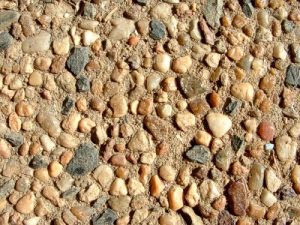
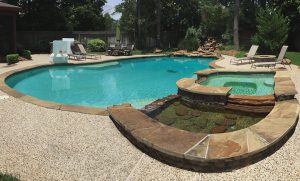
To clarify, while they are correctly referred to as “aggregate,” the pebble covered pool bottoms are an “exposed” aggregate. Aggregate countertops are very similar in nature but they have a beautifully smooth texture. They can be just as smooth as quartz. The customizable options with these counters are vast.
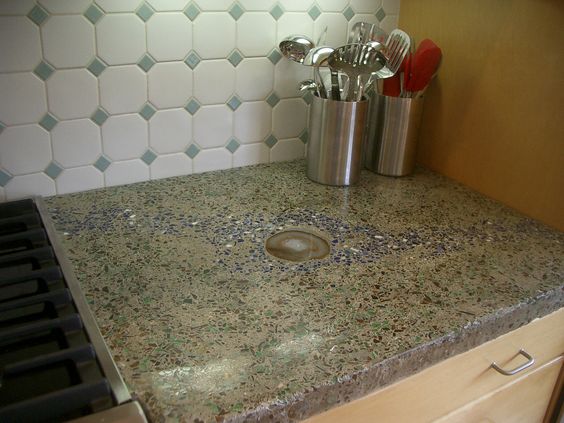
Like other concrete countertops, you will have to seal terrazzo counters every few years. Some companies, like “Icestone” make a form of aggregate countertops that use crushed glass instead of small rocks. These tiny prisms of glass make for eye-catching countertops that are technically using re-purposed material, so they are both attractive and green.
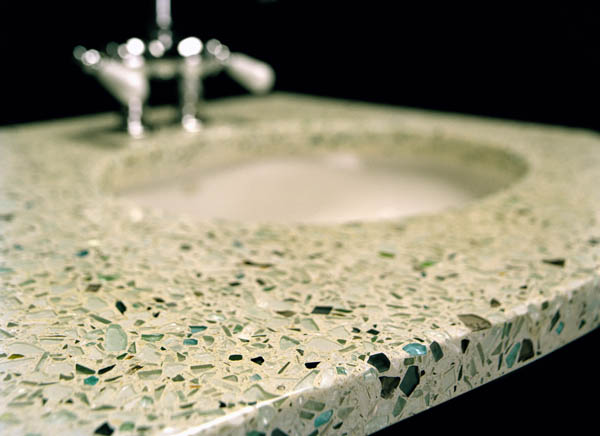
The shear fact that these countertops are made from concrete makes them a little more labor intensive than natural stone. For all its benefits, many people prefer concrete over the more traditional countertop material.
Tile
Traditional tile countertops used to be everywhere. Their popularity seems to be on the decline. If I had to guess, I would say that this is largely due to people being turned off to these counters by the idea of cleaning grout lines. I have always found this amusing because I grew up with tile counters and I almost never had to clean anything out of the grout.
Ceramic
Most tiles, be it countertops, backsplashes, or flooring, are made of some kind of ceramic. Ceramic tiles have a lot of factors that many would find positive and negative. Most people have seen some tiled counter in their life that they thought looked cheap,
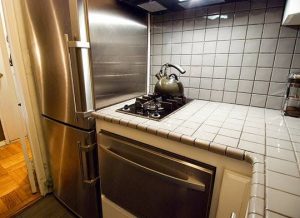
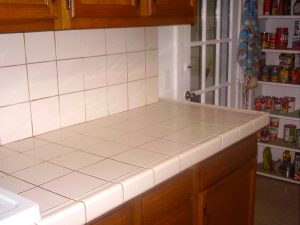
tacky, or out of date. (they last a long time) But for every one of these there will be several beautiful counters that are unquestionably the visual focal point of the kitchen. Tile gives you a seeming endless combination of colors, patterns, shapes, and designs.
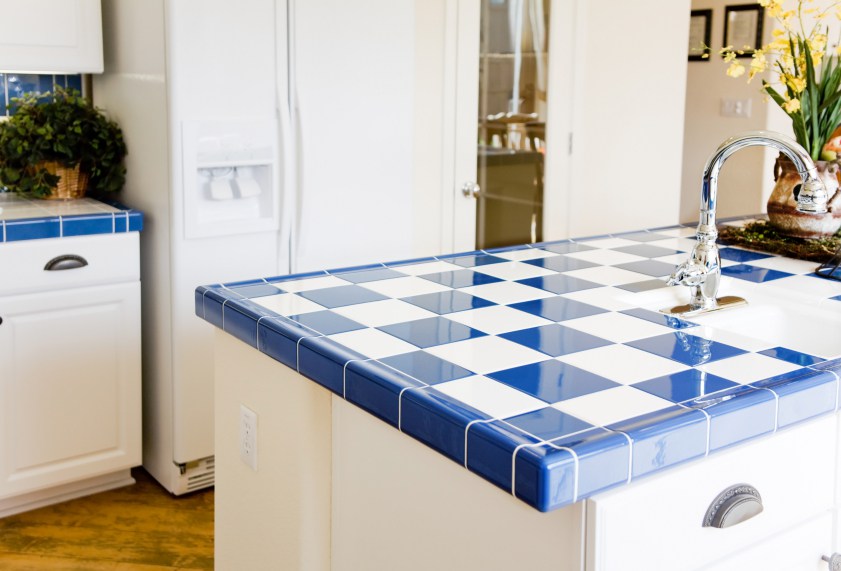
This gives you the ability to create vastly different looks for you kitchen. As if that were not enough, you can also use textured tiles to create even more options. Ceramic tile also has a great resistance to heat. I have personally moved many hot pots that were boiling over directly onto the tile counter next to my range without ever having a problem.
Unfortunately, it is not all positive. As I said before, there is a growing intolerance for cleaning grout lines. Anytime you have tiles, you have to have some grout joints that hold it all together. These lines of grout will have to be sealed every few years to keep them from staining. Some people say that you must clean up spills right away to prevent staining but it’s not true, in my experience. The grout is just like concrete; it’s porous but once it is sealed, it is not a problem. The grout lines are sunken so it might take a few more moments to wipe off a dirty area of the counter when compared to a smooth countertop like stone. It is also worth mentioning that the ceramic tiles themselves are not super strong. They should last a long time but if a heavy object is dropped on them, they can crack. This might not be a terrible problem if you thought to keep some spare tiles left over from the installation. Individual tiles can be replaced assuming you have the right tile to do so.
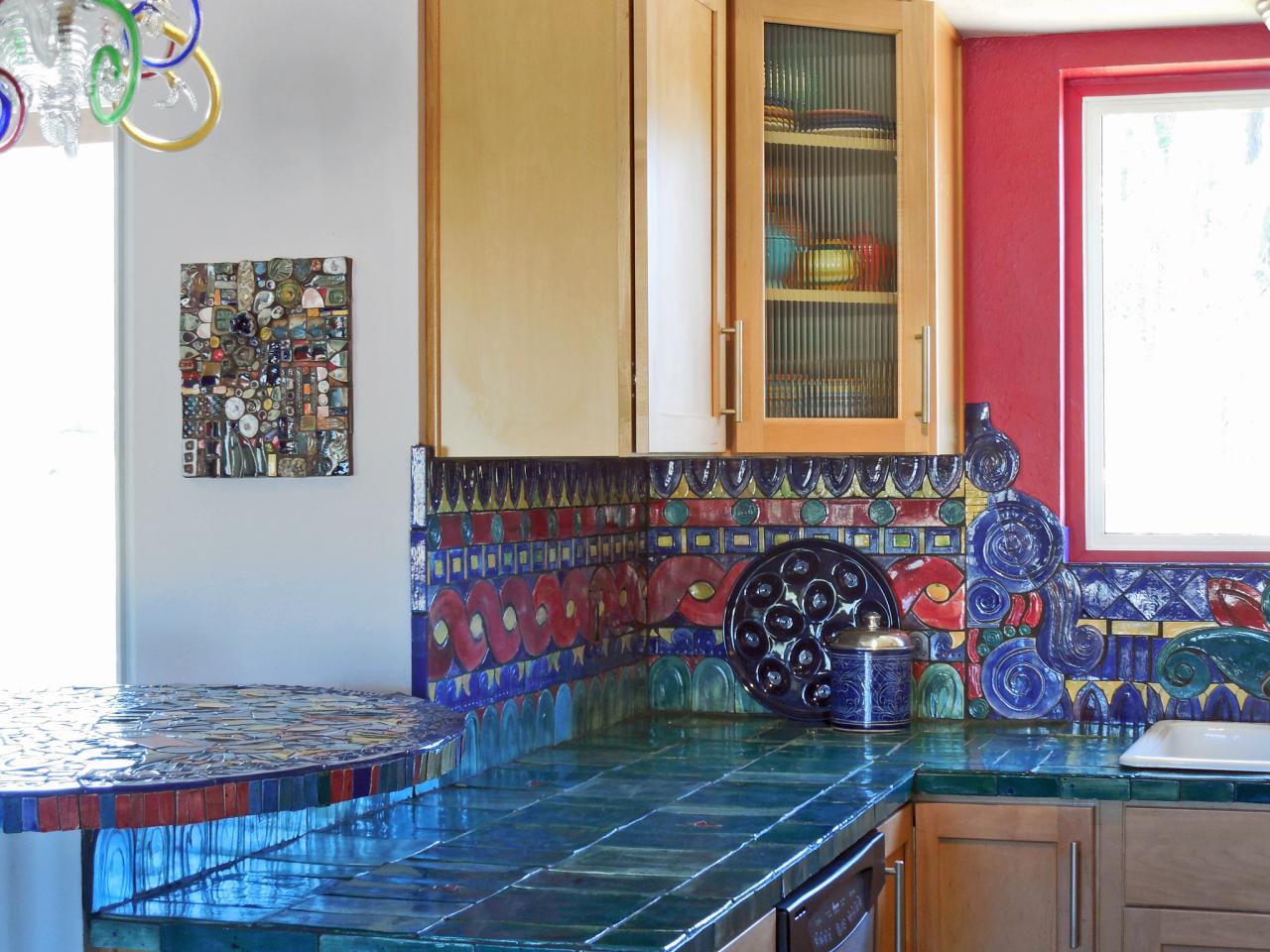
If those drawbacks do not deter you, then ceramic tiles can be a wonderful option for kitchen countertops. When compared to most other forms of countertop material, ceramic tiles are some of the most affordable.
Porcelain
Porcelain is a form of ceramic material that is commonly used in toilets. An easy way to distinguish the two is to think of porcelain as a super ceramic. Porcelain clay is made from very fine particles and cooked at a higher temperature. So porcelain is harder, denser, and less porous than normal ceramic tiles. Naturally, it also costs more. In terms of looks, anything you can do with ceramic tiles you can also do with porcelain tiles. In my kitchen flooring article I mention that porcelain tiles are becoming increasingly popular as flooring material because you can opt for textured porcelain that will convincingly looking and feel like wood, stone, brick, or any number of other materials.
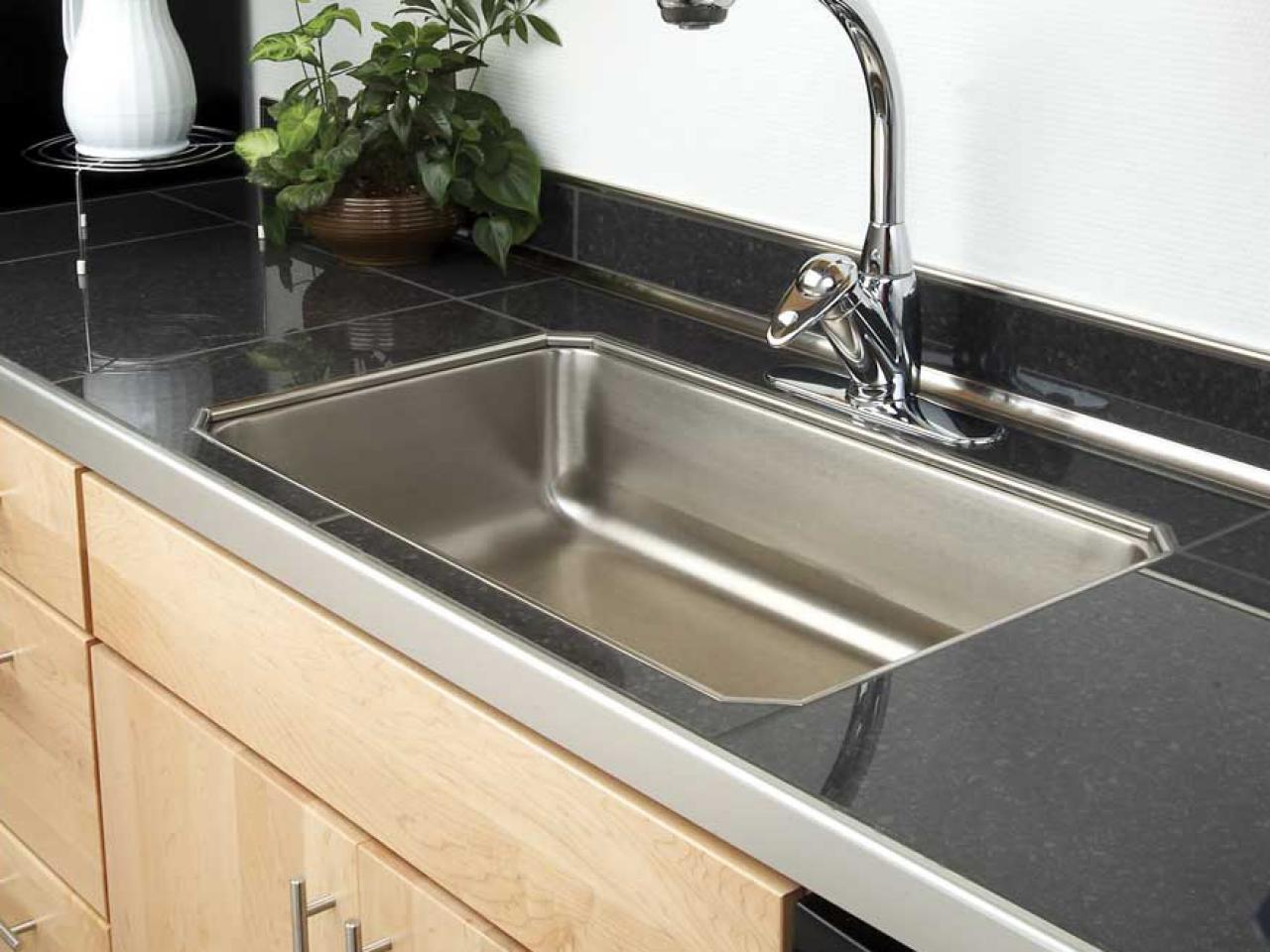
The same texturing techniques can be used to make excellent countertop tiles for you kitchen. As one would expect, you have the same grout issues with porcelain tile as you would with ceramic tiles. Also you will have to pay more for porcelain tile than you would ceramic tile, and you will pay significantly more for textured porcelain than you will un-textured porcelain.
Terra Green
I thought it worth mentioning that a company called Terra Green has been making counter tiles that incorporate recycled glass and metal into their clay. The result is a strong ceramic tile that is made from about 55% recycled material. If this information is correct then this would probably be one of the greener options out there in kitchen countertops.
Tile countertops have a lot going for them. They clearly require a little more effort to maintain than most stones but not much more than concrete countertops.
Hard Surface
Hard Surface is a general term for a man-made material that is made from things like acrylic, epoxy, and resins. Generally hard surface material is used for countertops. Like many other great innovations, the initial invention of hard surface material was brought to us by DuPont. In the 60’s they created Corian which was technically the first hard surface.
Corian
A hard material that is mostly made from acrylic polymer and something called alumina trihydrate. (ATH for short)
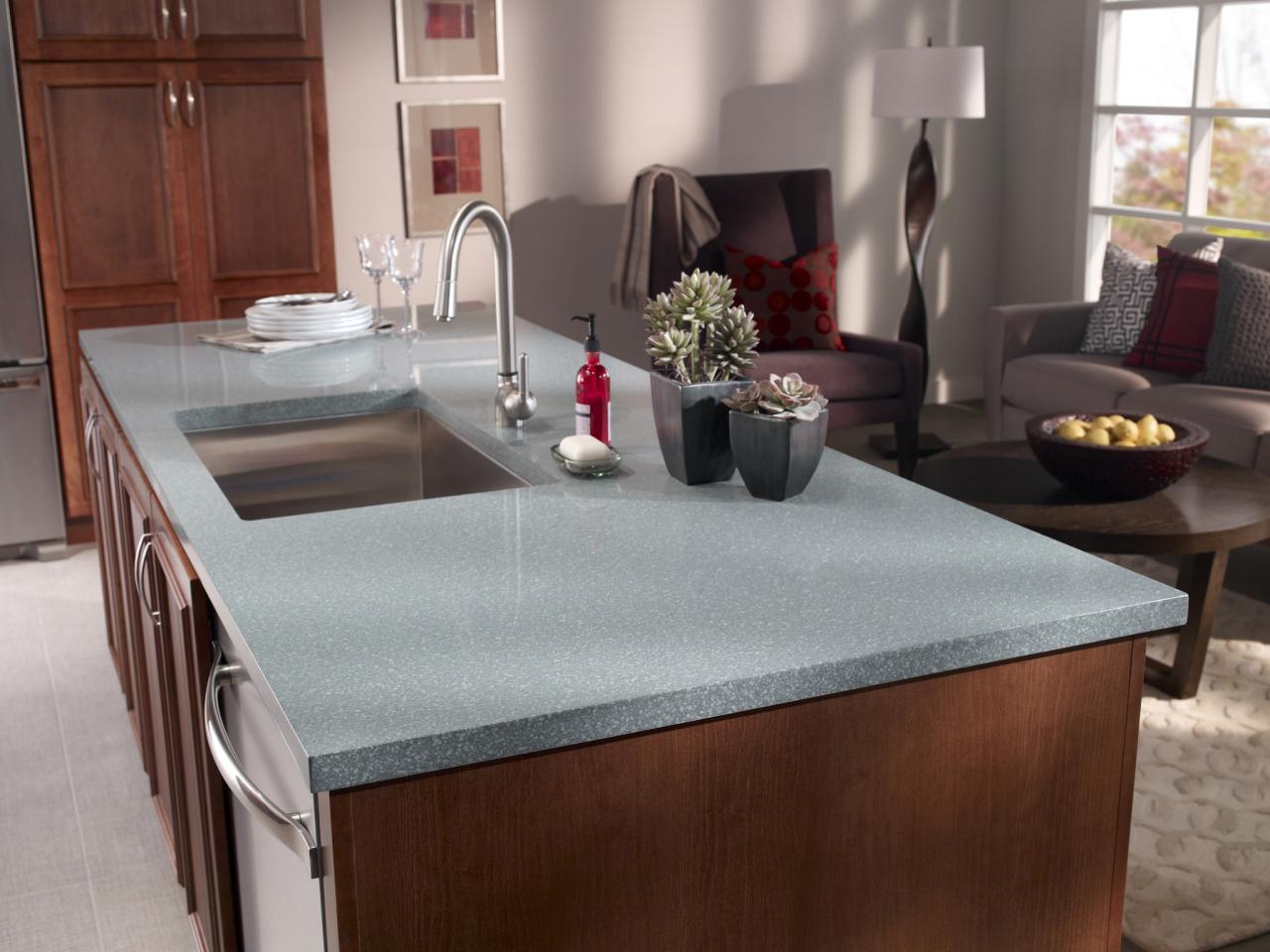
The best features of Corian are it’s smooth and seamless appearance. Corian is also a very durable material that can be made to look and imitate marble, granite, concrete, or a number of other materials. It’s smooth surface makes it very easy to clean.
Corian is not hard to damage with stains or scratches but both of these issues can be corrected rather easily with a sanding process. It can also be damaged by heat. If you remember my personal countertop priorities that I previously mentioned, then you probably correctly assumed that although Corian is an impressive material, I am not a fan.
Laminate
Laminate is a form of hard surface that is made from layering sheets of plastic and resin and then bonding it to a piece of plywood or particleboard. Like all hard surface materials, laminate countertops have a large variety in color and texture. The biggest advantage of laminate countertops is that it is the most affordable countertop material. This is part of the reason why you find laminate in so many apartments.
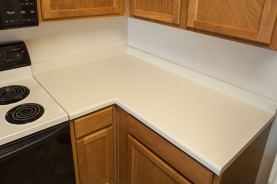
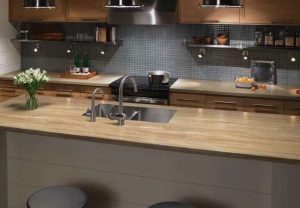
Formica is a major brand of laminate countertops that uses melamine. Compared to Corian, Formica and other laminates cost a lot less and are easier to install if you want to try to attempt it yourself. However laminate countertops will NOT last as long as Corian and you cannot sand out scratches like you can with Corian. Just like all the other hard surface materials, laminate countertops do not do well with heat. With laminate the monetary savings cannot be denied, but remember that because it is the cheapest, it also has a reputation for being the go-to choice for apartments and low end housing.
SwanStone, Avonite, Meganite, etc.
For over 30 years DuPont held the patent on hard surface countertops. Now that the patent is over, the copycats have come out of the woodwork. SwanStone, Avonite, and Meganite all seem to be products that are extremely similar to Corian.
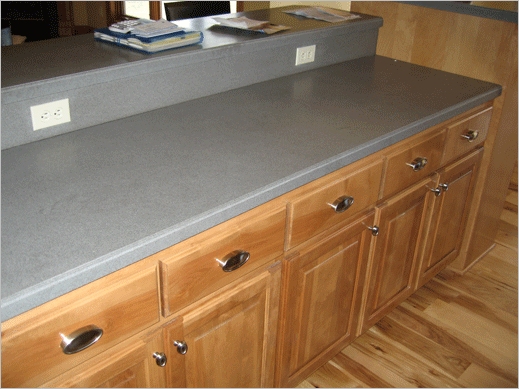
Even Formica makes a “Formica Solid Surface” that is practically the same as Corian. It should be mentioned that some of these competitors, like Swan Stone, will end up costing you significantly less money to purchase than Corian.
Richlite, PaperStone, etc.
For anyone who is looking for new counters of the eco-friendly variety; there is a company called Richlite that makes a strong and durable solid surface countertop material by using non-toxic resins and layers of recycled paper. Shetkastone and Paperstone also make very similar products.
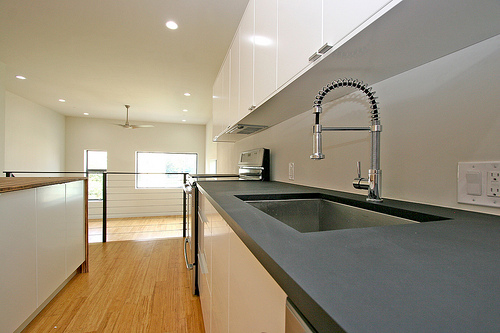
The cool thing about these products is that they end up with a very stone-like texture and appearance. They are also nonporous as you should expect from hard surface. Interestingly they also weigh less than natural stone and are warmer to the touch. Unfortunately while these paper stones do get high marks for in many important areas, their heat tolerance is not much better than most other solid surfaces.
If you have read my article on “green kitchens” then you know that I am passionate about green innovation and environmental issues but I am also highly skeptical of ALL so-called “green” or “eco-friendly” products and companies. I have not taken the time to research where and how these paper stone companies get their “recycled” materials from, but that term is always a red flag for me. It would be disappointing to learn that these countertops are less “eco-friendly” than they seem. The description of their product seems a lot like repurposing paper into a very useful product so that sounds positive. I hope that I am right.
Wood
A far less common material to see in a kitchen countertop is wood. I hate to sound bias, but to me there are two basic types of wooden countertops that are used in kitchens; one is very good and the other is not.
Butcher Block
We all have those cutting boards that we keep handy to lay on the countertop and slice bread, or tri tip, cut onions, etc. So why not cut out the middleman and just make the counter itself one giant cutting board?
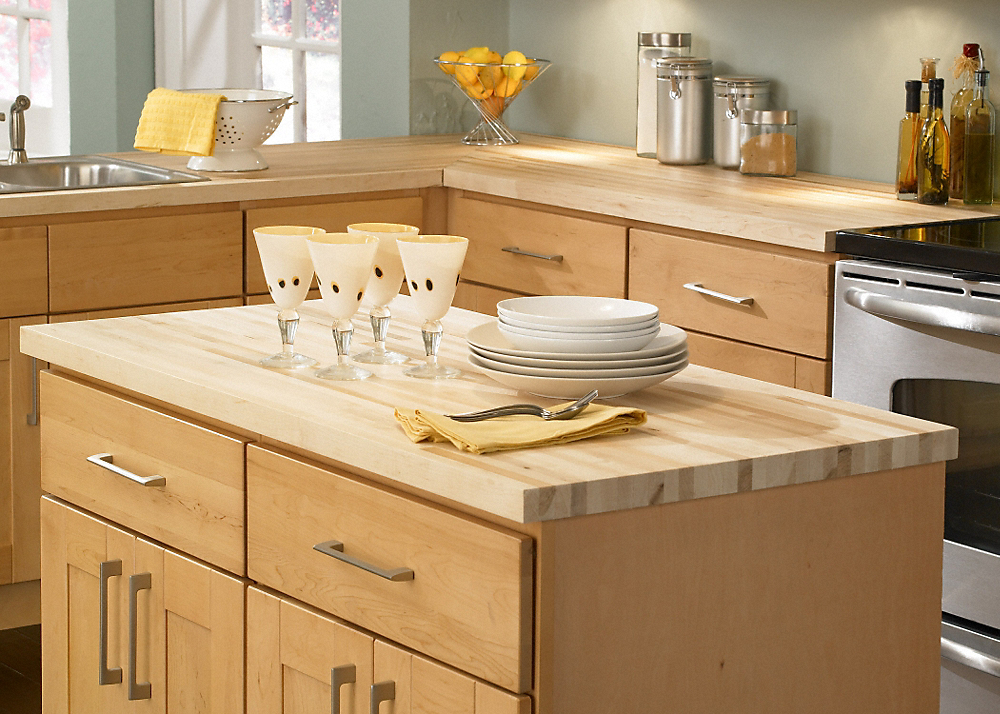
The term “butcher block” usually refers to a certain design of extra strong cutting board that are used for chopping. Butcher blocks tend to differ from other wooden cutting boards in that they are thicker, and utilize an “end-grain” design. For convenience within this article, I am referring to any wooden countertop surface that is made to have things cut on it, as butcher block. The hardwoods used to make quality cutting boards and butcher blocks are very expensive but not compared to what people pay for stone, quartz, and most other countertops.
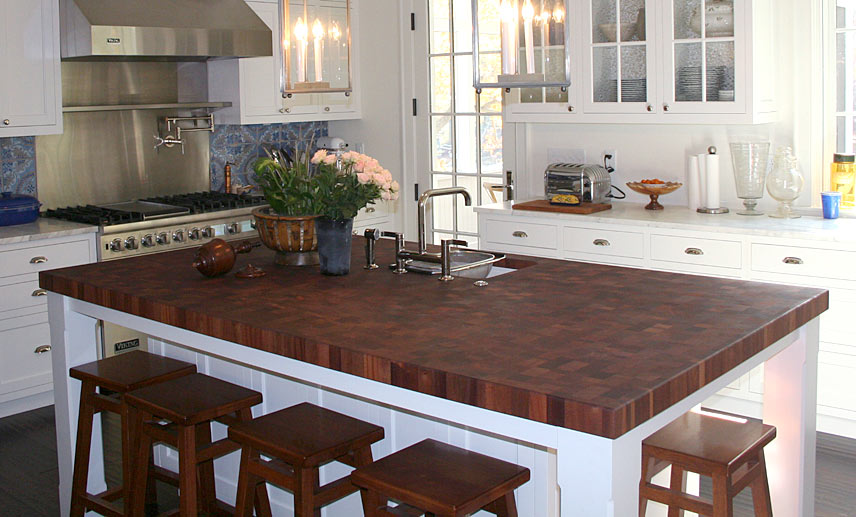
The vast majority of the time you see this material being used it is as an island or a particular part of kitchen work station. They tend to draw attention like a nice accent piece in most kitchens but there are some who use butcher block counters for half or all of their kitchen.
The benefits of this material are fairly obvious. Butcher block is strong. Dropping your cast iron comal from an upper cabinet onto your counter is reason for concern with practically any countertop materials, but not this one. You get the unparalleled convenience of chopping veggies and slicing meat ANYWHERE in your kitchen. No more problems with chipping, cracking or breaking. It is possible that you could spill something that would stain the wood and/or you could chop or cut grooves into the wood, but even sever cases of both these problems can be fixed with a little sanding and some oil.
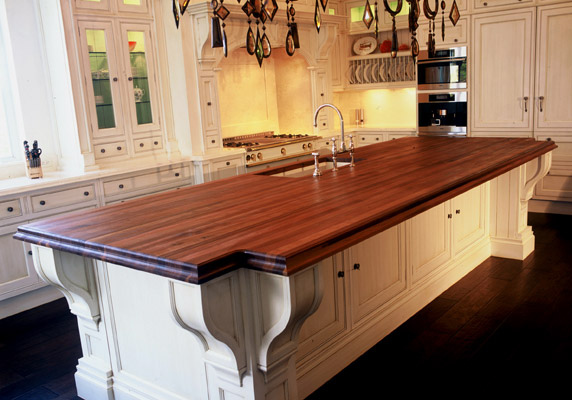
If you were to place an incredibly hot object on the countertop it is possible that a burned area would show up but that too, can be fixed with relative ease. Many people think that butcher block counters will attract bacteria but recent studies have shown that the “safer” poly cutting boards do nothing to protect you from bacteria while wood cutting boards actually kill bacteria. This flies in the face of public opinion but the research is very clear.
The only real drawbacks with butcher block countertops are ones of personal preferences. Many people, myself included, feel that butcher block countertops work best in smaller doses. Some people do spring for the full kitchen conversion but not as many as you would expect considering the benefits.
Non-Butcher Block
It is not common but some kitchens have small wooden countertops that are stained and not made to be cut on any more than hard surface materials. I love woodworking and I love the way wood looks. I can understand the visual appeal of having some beautiful stained wood countertops in your kitchen. I can understand the desire for them.

But stained wooden countertops will be one of the most easily damaged countertops you could ever get. There is a reason why we don’t chop veggies or use blenders, mixers, and rolling pins on the top of an antique cherry wood desk. It’s gonna get messed up!
Glass
There is really only one category to talk about with this material. Although it is not common in most household kitchens, some countertops are being made from thick tempered glass.

Visually the benefits of this material are very apparent. Glass counters offer stunning and clean looking countertops that will add to any modern kitchen. The options for color and texture are vast. If you think that Onyx countertops look amazing when you light them from below, you haven’t seen anything yet.
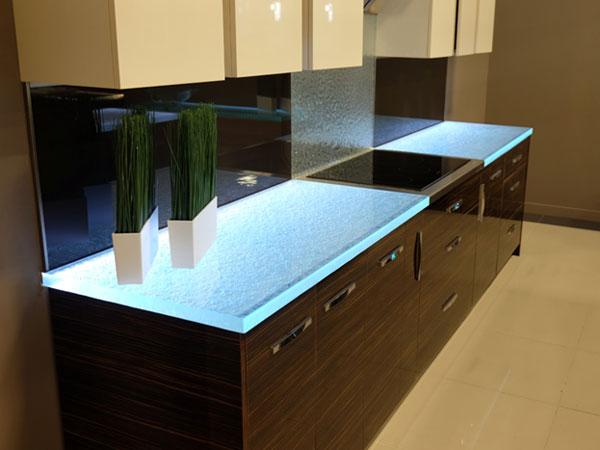
A properly illuminated glass counter can take on a futuristic look that dares you to ignore its presents within the room.
With glass counters you will also not have to worry about seams or slabs being joined together. The glass can be formed into most any size and shape to fit the needs of your counter. There are ways for glass to match with most any other materials you use for back splashes, and cabinets. Glass counters do not wear out and you don’t need to ever worry about staining or discolorations. One of the most important factors is that glass countertops are extremely heat resistant. You will have no problems placing hot pans right on the glass. Glass is super easy to clean and keep clean. Of course, you can crack, chip, or break your glass counter and fixing it will not be cheap. Also purchasing and installing the large heavy pieces of glass can be costly.
This beautiful and exotic countertop option will not be for everyone but if you are looking for a unique option for your kitchen, glass might be the way to go.
Metal
Nearly every restaurant and commercial kitchen in the world uses stainless steel for its appliances, fixtures, and countertops. They use metal for nearly everything they can get away with making out of metal. Surely they can’t all be wrong.
Stainless Steel
Stainless steel has many benefits that make it one of the best options for your kitchen countertop. A countertop made of stainless steel will be very easy to clean and disinfect. There are so many products that can be found at Smart n Final or other restaurant stores that are specially made for stainless steel. This is one of the most indestructible materials you will find for kitchen counters.
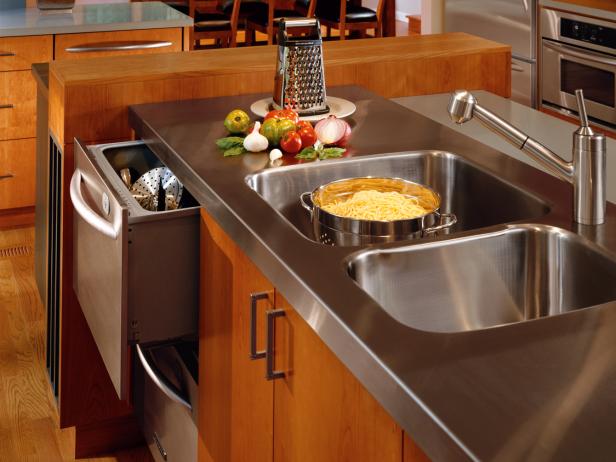 If you dropped a really heavy object on the counter, it could dent but you don’t have to worry about the cracking, chipping, breaking, or discoloring issues that are so prevalent in other countertop materials. No burning and no rusting, these counters are strong and low maintenance. Stainless steel would not be damaged if you were to do some light cutting right on the surface of your countertops, but you should probably avoid doing this too much because scratches could occur and it could dull your knife edges. Some people don’t like the cold industrial feel that stainless steel brings to your kitchen but you should also consider how professional it looks. If you are serious and passionate about the cooking you do in your kitchen, stainless steel countertops can really mirror that enthusiasm.
If you dropped a really heavy object on the counter, it could dent but you don’t have to worry about the cracking, chipping, breaking, or discoloring issues that are so prevalent in other countertop materials. No burning and no rusting, these counters are strong and low maintenance. Stainless steel would not be damaged if you were to do some light cutting right on the surface of your countertops, but you should probably avoid doing this too much because scratches could occur and it could dull your knife edges. Some people don’t like the cold industrial feel that stainless steel brings to your kitchen but you should also consider how professional it looks. If you are serious and passionate about the cooking you do in your kitchen, stainless steel countertops can really mirror that enthusiasm.
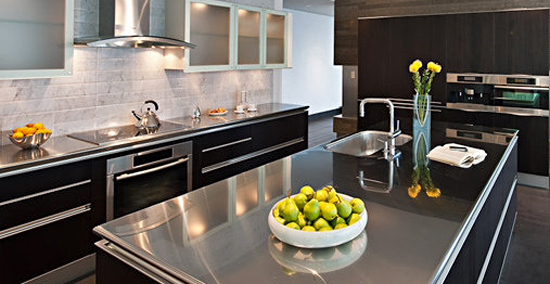
Even if you use a lot of steel, paring with the right cabinets and floors will give your kitchen a lot of character.
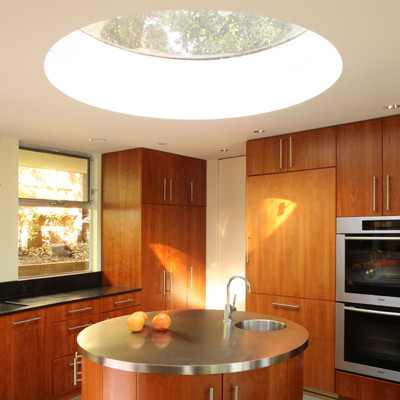
The skylight works perfectly with this stainless steel island. Stainless steel is a relatively easy material to install and if you care about the green aspect, it is also recyclable should you ever rip it out in the future.
Heavy metal objects will not damage the stainless steel countertop but over the years the tiny scratches will turn into signs of wear. Stainless steel is also not cheap. Prices will vary but don’t expect to get good thick steel for less than what you’d pay for granite.
Other Metal
If you want metal countertops but you want the counters to match your copper bottom pots and pans, or if you love the steam-punkish feel of copper over steel, then you could opt for copper countertops rather than steel. Copper naturally has some antibacterial properties so that may be why it has some fans. Copper counters are definitely not for everyone. You have to seal and wax copper countertops to keep them looking new. Some people are not really interested in pristine copper and would prefer to let their counters age and change with time.
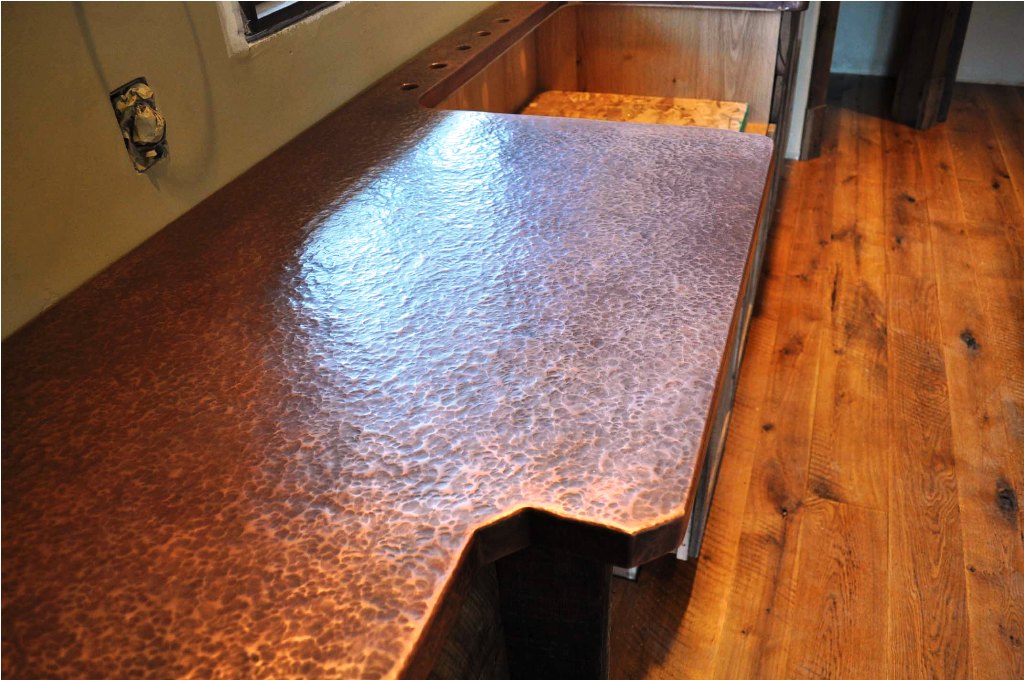
To me, this seems like a large price to pay for a particular look. Copper does not perform as well as Stainless steel. It is softer and much easier to dent, scratch and damage. I would bet that if you really wanted a specific kind of aged copper look to complement your Victorian era themed kitchen, there is probably a porcelain or ceramic that will look just like oxidized copper but will make a much more usable countertop. But maybe I just don’t value the same priorities.
Zinc has many of the same properties as copper. Zinc is soft, and easily damaged. Anything around 300 degrees or hotter could seriously warp your zinc countertops. You pretty much need to want aged countertops that will develop a patina, just like copper, if you want to buy zinc. As I stated before, if you want a nice shiny metal countertop, you really should stick with stainless steel.
There are many varieties of countertop materials to choose from. Knowing the specific priorities that you want for your kitchen counters will help immensely but another thing that could help would be knowing what kind of cabinets, back splashes, and appliances you plan to use. That way you can match colors and styles. For example: Sometimes it can be beautiful to have matching tiles for the counter and backsplash. But if you buy some truly stunning tiles for your colorful backsplash, maybe you should try to make them stand out with a dark simple quartz countertop.
Also, whether you are buying new fixtures and appliances or keeping your old ones, make sure they don’t clash with your new countertop. Naturally, when talking about matching countertops to appliances and fixtures, one tends to think about the kitchen sink. I have a previous article all about the importance of kitchen sinks. Choosing the right sink can be vital to picking the right countertop.
It’s ok to go heavy on a material you like, but don’t go overboard. Johnny Cash found a way to make “black on black on black” work for his wardrobe but that might not be the best mindset for kitchens. Both of these pictures show kitchens with what many people would call an excessive amount of wood.
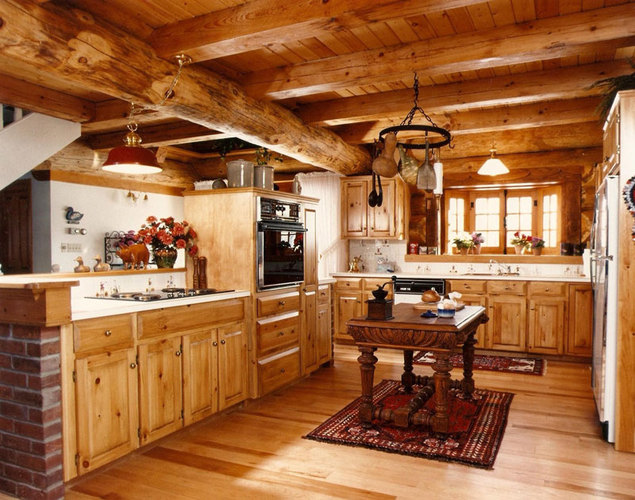
Wood is beautiful but if you have wood floor, wood cabinets, and a dominating wood ceilings, this simple white counter and small backsplash doesn’t do enough to create any balance.
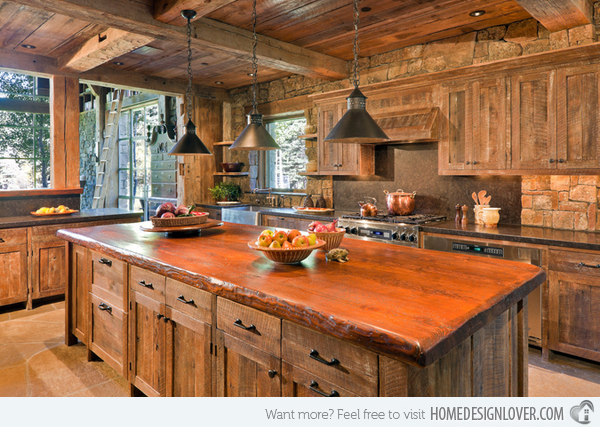
But this kitchen with about the same amount of wood has a nice tile floor with stone walls and some sort of dark stone countertops which give it enough balance to have a massive wood island and still work. Many people want white cabinets with white stone countertops. If your kitchen looks like it is going to be too white you can get two-tone cabinets to balance out the colors. Sometimes it is possible to have too much of a good thing.
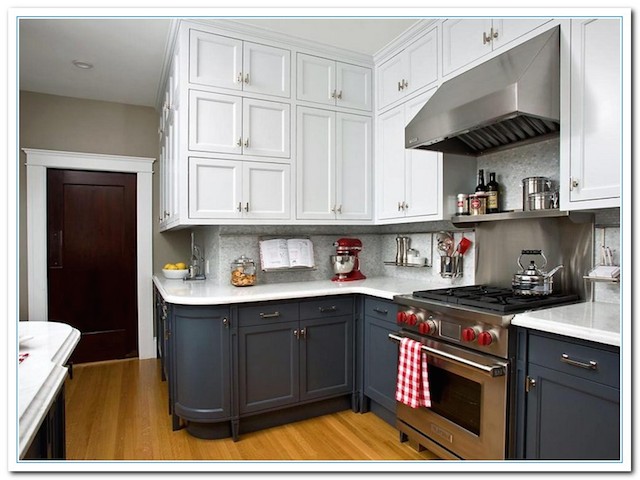
When you know what materials you want and you know the balance of materials you are going for, you can even create some great combinations of countertop materials to give your kitchen a better look and sometimes more functionality. This nice looking kitchen features an impressive multi-level island with stone countertops, a small pub sink, and a fairly large butcher block area.
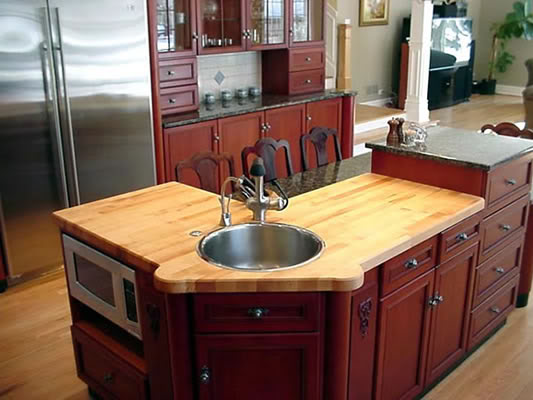
Whatever the material you decide on for your kitchen countertop, it is good to know what is out there and what options you have. So figure out what priorities you have for your kitchen and then see how that translates to what material you would like for your countertops.

